Drive Mechanisms of Soil Quality Changes in Peri-Urban Areas
Abstract
1. Introduction
2. Theoretical Framework
2.1. Definitions
2.1.1. FLUB
2.1.2. SQ
2.2. The Driving Mechanism of SQ Change by the FLUB
3. Materials and Mixed Methods Approach
3.1. Study Sites
3.2. Data Collection and Processing
3.2.1. SQ Sampling A Data and Preprocessing
3.2.2. Socio-Economic Datasets
3.3. Econometric Models
4. Results and Discussion
4.1. The Spatial and Temporal Variation of SQ in the Metropolitan Suburbs
4.1.1. The Spatial-Temporal Variation of OM
4.1.2. The Spatial-Temporal Variation of AVN
4.1.3. The Spatial-Temporal Variation of AVP
4.1.4. The Spatial-Temporal Variation of AVK
4.2. FLUB and SQ: the Driving Mechanism
4.2.1. Temporal Variation of FLUB
Land Use Pattern (WGCC)
Land Use Degree (MCI)
Land Input Intensity (LII)
4.2.2. Spatial Difference of FLUB in 2010
Land Use Pattern (WGCC)
Land Use Degree (MCI)
Land Input Intensity (LII)
4.2.3. The Response of SQ to Farmer Land Use Behavior: An Empirical Analysis FLUB
The Response of SQ to Type III Farmers in the Inner Suburb
The Response of SQ to Type II Farmer in the Middle Suburb
The Response of SQ to Type I Farmer in the Outer Suburb
5. Conclusions
Supplementary Materials
Author Contributions
Funding
Institutional Review Board Statement
Informed Consent Statement
Data Availability Statement
Conflicts of Interest
Glossary
| Abbreviation | Definition |
| CLQ | Cultivated land quality |
| FLUB | Farmers’ land use behavior |
| OM | Organic matter |
| AVN | Available nitrogen |
| AVP | Available phosphorus |
| AVK | Available potassium |
| PUA | Peri-urban agriculture |
| WGCC | Whether grow cash crop |
| MCI | Multiple cropping index |
| LII | Land input intensity |
| Type I farmer | Whose income mainly comes from farming |
| Type II farmer | Who has concurrent off-farm employment, but farming is still the major income source |
| Type III farmer | Who has a concurrent off-farm employment, but off-farm income becomes the major income source |
| N | Nitrogen |
| P | phosphorus |
| K | potassium |
References
- Wu, Y.; Shan, L.; Guo, Z. Cultivated Land Protection Policies in China Facing 2030: Dynamic Balance System Versus Basic Farmland Zoning. Habitat Int. 2017, 69, 126–138. [Google Scholar] [CrossRef]
- Zhang, W.; Wang, W.; Li, X. Economic Development and Farmland Protection: An Assessment of Rewarded Land Conversion Quotas Trading in Zhejiang, China. Land Use Policy 2014, 38, 467–476. [Google Scholar] [CrossRef]
- Li, M. The Effect of Land Use Regulations on Farmland Protection and Non-Agricultural Land Conversions in China. Aust. J. Agric. Resour. Econ. 2019, 63, 643–667. [Google Scholar] [CrossRef]
- Huang, Z.; Du, X.; Castillo, C.S.Z. How Does Urbanization Affect Farmland Protection? Evidence from China. Resour. Conserv. Recycl. 2019, 145, 139–147. [Google Scholar] [CrossRef]
- Cheng, L.; Jiang, P.; Chen, W. Farmland Protection Policies and Rapid Urbanization in China: A Case Study for Changzhou City. Land Use Policy 2015, 48, 552–566. [Google Scholar]
- Zhong, T.; Mitchell, B.; Scott, S. Growing Centralization in China’s Farmland Protection Policy in Response to Policy Failure and Related Upward-Extending Unwillingness to Protect Farmland Since 1978. Environ. Plan. C—Politics Space 2017, 35, 1075–1097. [Google Scholar] [CrossRef]
- Wu, K.; Han, C.; Sun, Z. Spatial and Temporal Distribution of Soil Fertility as Affected by Urbanization. Chin. J. Soil Sci. 2007, 38, 242–246. [Google Scholar]
- Shi, Y.; Duan, W.; Fleskens, L.; Li, M.; Hao, J. Study on Evaluation of Regional Cultivated Land Quality based on Resource-Asset-Capital Attributes and Its Spatial Mechanism. Appl. Geogr. 2020, 125, 102284. [Google Scholar] [CrossRef]
- Brunori, E.; Salvati, L.; Antogiovanni, A.; Biasi, R. Worrying about ‘Vertical Landscapes’: Terraced Olive Groves and Ecosystem Services in Marginal Land in Central Italy. Sustainability 2018, 10, 1164. [Google Scholar] [CrossRef]
- Tang, H.; Wu, W.; Yu, Q. Agricultural Land System Research and Its Key Scientific Problems. Sci. Agric. Sin. 2015, 48, 900–910. [Google Scholar]
- Kong, X.; Li, C.; Liang, Y. Arable Land Productivity and its Elastic Loss on the Basis of Farm Household Land Use Behavior. Prog. Geogr. 2010, 29, 869–877. [Google Scholar]
- Cai, Y.; Yu, L. Rural Household Participation in and Satisfaction with Compensation Programs Targeting Farmland Preservation in China. J. Clean. Prod. 2018, 205, 1148–1161. [Google Scholar] [CrossRef]
- Zhong, T.; Huang, X. Review on the Researches of Land Use Change at Farm Household Level. J. Nat. Resour. 2007, 22, 341–352. [Google Scholar]
- Kong, X.; Liu, L.; Qin, J. Theory and Methodology for the Construction of Arable Land Quality Evaluation System Based on Household Behaviors. Prog. Geogr. 2007, 26, 75–85. [Google Scholar]
- Chen, M.; Wu, Y.; Liu, T. Research and Prospect of Farmland Protection in China Based on Farmers’ Behavior. J. Nanjing Agric. Univ. 2012, 12, 66–72. [Google Scholar]
- Silva, A.M.M.; Ramos, M.L.G. Soil Quality Indicators under Management Systems in a Quilombola Community the Brazilian Cerrado. Sci. Agric. 2019, 76, 518–526. [Google Scholar] [CrossRef]
- Sefati, Z.; Khalilimoghadam, B.; Nadian, H. Assessing Urban Soil Quality by Improving the Method for Soil Environmental Quality Evaluation in a Saline Groundwater Area of Iran. Catena 2019, 173, 471–480. [Google Scholar] [CrossRef]
- Romano-Armada, N.; Amoroso, M.J.; Rajal, V.B. Construction of a Combined Soil Quality Indicator to Assess the Effect of Glyphosate Application. Sci. Total Environ. 2019, 682, 639–649. [Google Scholar] [CrossRef]
- Ratcliffe, S.; Bosman, B.; Carnol, M. Spatial and Temporal Variability of Biological Indicators of Soil Quality in Two Forest Catchments in Belgium. Appl. Soil Ecol. 2018, 126, 148–159. [Google Scholar] [CrossRef]
- Tang, L.; Hayashi, K.; Ohigashi, K. Developing Characterization Factors to Quantify Management Impacts on Soil Quality of Paddy Fields within Life Cycle Assessment. J. Clean. Prod. 2019, 238, 1–10. [Google Scholar] [CrossRef]
- Van Leeuwen, J.P.; Creamer, R.E.; Cluzeau, D. Modeling of Soil Functions for Assessing Soil Quality: Soil Biodiversity and Habitat Provisioning. Front. Environ. Sci. 2019, 7, 47–52. [Google Scholar] [CrossRef]
- Lyu, K.; Chen, K.; Zhang, H. Relationship between Land Tenure and Soil Quality: Evidence from China’s Soil Fertility Analysis. Land Use Policy 2019, 80, 345–361. [Google Scholar] [CrossRef]
- Ruf, T.; Makselon, J.; Udelhoven, T. Soil Quality Indicator Response to Land-Use Change from Annual to Perennial Bioenergy Cropping Systems in Germany. Glob. Chang. Biol. Bioenergy 2018, 10, 444–459. [Google Scholar] [CrossRef]
- Viaud, V.; Santillan-Carvantes, P.; Akkal-Corfini, N. Landscape-Scale Analysis of Cropping System Effects on Soil Quality in a Context of Crop-Livestock Farming. Agric. Ecosyst. Environ. 2018, 265, 166–177. [Google Scholar] [CrossRef]
- Nilsson, P. The Role of Land Use Consolidation in Improving Crop Yields among Farm Households in Rwanda. J. Dev. Stud. 2019, 55, 1726–1740. [Google Scholar] [CrossRef]
- Dib, J.B.; Krishna, V.V.; Alamsyah, Z. Land-Use Change and Livelihoods of Non-Farm Households: The Role of Income from Employment in Oil Palm and Rubber in Rural Indonesia. Land Use Policy 2018, 76, 828–838. [Google Scholar] [CrossRef]
- Xu, D.; Guo, S.; Xie, F. The Impact of Rural Laborer Migration and Household Structure on Household Land Use Arrangements in Mountainous Areas of Sichuan Province, China. Habitat Int. 2017, 70, 72–80. [Google Scholar] [CrossRef]
- Hayes, T.; Murtinho, F.; Wolff, H. The Impact of Payments for Environmental Services on Communal Lands: An Analysis of the Factors Driving Household Land-Use Behavior in Ecuador. World Dev. 2017, 93, 427–446. [Google Scholar] [CrossRef]
- Tian, Q.; Brown, D.G.; Zheng, L. The Role of Cross-Scale Social and Environmental Contexts in Household-Level Land-Use Decisions, Poyang Lake Region, China. Ann. Assoc. Am. Geogr. 2015, 105, 1240–1259. [Google Scholar] [CrossRef]
- Luo, X.; Feng, S.; Reidsma, P. Agricultural and Environmental Policy Response Simulation Based on the Household Bioeconomy Model—A Case Study of the Taihu Lake Basin. Chin. Rural Econ. 2013, 11, 72–85. [Google Scholar]
- Naab, J.B.; Mahama, G.Y.; Yahaya, I. Conservation Agriculture Improves Soil Quality, Crop Yield, and Incomes of Smallholder Farmers in North Western Ghana. Front. Plant Sci. 2017, 8, 1–12. [Google Scholar] [CrossRef]
- Wang, Y.; Bilsborrow, R.E.; Zhang, Q. Effects of Payment for Ecosystem Services and Agricultural Subsidy Programs on Rural Household Land Use Decisions in China: Synergy or Trade-Off? Land Use Policy 2019, 81, 785–801. [Google Scholar] [CrossRef]
- Trung, T.N.; Bauer, S.; Grote, U. Does Land Tenure Security Promote Manure Use by Farm Households in Vietnam? Sustainability 2016, 8, 1–9. [Google Scholar]
- Wang, C.; Wang, L.; Jiang, F. Differentiation of Rural Households’ Consciousness in Land Use Activities: A Case from Bailin Village, Shapingba District of Chongqing Municipality, China. Chin. Geogr. Sci. 2015, 25, 124–136. [Google Scholar] [CrossRef]
- Song, J.; Wang, R. Measuring the Spatial Dimension of Automobile Ownership and its Associations with Household Characteristics and Land Use Patterns: A Case Study in Three Counties, South Florida (USA). Sustainability 2017, 9, 558. [Google Scholar] [CrossRef]
- Ahimbisibwe, V.; Auch, E.; Groeneveld, J. Drivers of Household Decision-Making on Land-Use Transformation: An Example of Woodlot Establishment in Masindi District, Uganda. Forests 2019, 10, 619. [Google Scholar] [CrossRef]
- Sakane, N.; Van Wijk, M.T.; Langensiepen, M. A Quantitative Model for Understanding and Exploring Land Use Decisions by Smallholder Agrowetland Households in Rural Areas of East Africa. Agric. Ecosyst. Environ. 2014, 197, 159–173. [Google Scholar] [CrossRef]
- Zimmerman, E.K.; Tyndall, J.C.; Schulte, L.A. Farmer and Farmland Owner Views on Spatial Targeting for Soil Conservation and Water Quality. Water Resour. Res. 2019, 55, 3796–3814. [Google Scholar] [CrossRef]
- Kuria, A.W.; Barrios, E.; Pagella, T. Farmers’ Knowledge of Soil Quality Indicators along a Land Degradation Gradient in Rwanda. Geoderma Reg. 2019, 16, 1–10. [Google Scholar] [CrossRef]
- Bai, Z.; Caspari, T.; Gonzalez, M.R. Effects of Agricultural Management Practices On Soil Quality: A Review of Long-Term Experiments for Europe and China. Agric. Ecosyst. Environ. 2018, 265, 1–7. [Google Scholar] [CrossRef]
- Omari, R.A.; Bellingrath-Kimura, S.D.; Addo, E.S. Exploring Farmers’ Indigenous Knowledge of Soil Quality and Fertility Management Practices in Selected Farming Communities of the Guinea Savannah Agro-Ecological Zone of Ghana. Sustainability 2018, 10, 1034. [Google Scholar]
- Liu, H.; Wang, Q.; Wu, Y. Research on Farmers’ Cognition Degree, Behavioral Decision Response and Influencing Mechanism in Farmland Quality Protection. China Land Sci. 2018, 32, 52–58. [Google Scholar]
- Tan, S.; Tan, Z.; Huang, X. Farm Households’ Behaviors and Soil Degradation in China: From the View of the New Institutional Economics. Soils 2004, 36, 141–144. [Google Scholar]
- Ouyang, J.; Song, C.; Yu, Z. Land Use Choice and Environmental Impact of Different Types of Farmers in Huang-Huaihai plain—A Case Study of Quzhou County, Hebei Province. J. Nat. Resour. 2004, 19, 1–11. [Google Scholar]
- Li, T.; Kong, X.B.; Liang, Y. Found the Research Frame on the Arable Land Evaluation Based On Household Decision Behavior. J. China Agric. Univ. 2010, 15, 101–107. [Google Scholar]
- Drobnik, T.; Greiner, L.; Keller, A. Soil Quality Indicators—From Soil Functions to Ecosystem Services. Ecol. Indic. 2018, 94, 151–169. [Google Scholar] [CrossRef]
- Bunemann, E.K.; Bongiorno, G.; Bai, Z. Soil Quality—A Critical Review. Soil Biol. Biochem. 2018, 120, 105–125. [Google Scholar] [CrossRef]
- Eagle, A.J.; Eagle, D.E.; Stobbe, T.E. Farmland Protection and Agricultural Land Values at the Urban-Rural Fringe: British Columbia’s Agricultural Land Reserve. Am. J. Agric. Econ. 2015, 97, 282–298. [Google Scholar] [CrossRef]
- Cary, J.W.; Wilkinson, R.L. Perceived Profitability and Farmers ‘Conservation Behaviour. J. Agric. Econ. 1997, 48, 13–21. [Google Scholar] [CrossRef]
- Willock, J.; Deary, I.J.; Edwards-Jones, G.; Gibson, G.J.; McGregor, M.J.; Sutherland, A.; Barry, D.J.; Morgan, O.; Grieve, R. The Role of Attitudes and Objectives in Farmer Decision Making: Business and Environmentally-Oriented Behaviour in Scotland. J. Agric. Econ. 1999, 50, 286–303. [Google Scholar] [CrossRef]
- Mills, J.; Gaskell, P.; Ingram, J.; Dwyer, J.; Reed, M.; Short, C. Engaging Farmers in Environmental Management through a Better Understanding of Behaviour. Agric. Hum. Values 2017, 34, 283–299. [Google Scholar] [CrossRef]
- Norton, G.W.; Alwang, J. Introduction to Economics of Agricultural Development. Am. J. Agric. Econ. 1993, 2, 160–164. [Google Scholar]
- Cak, A.D.; Moran, E.F.; Figueiredo, R.D.O. Urbanization and Small Household Agricultural Land Use Choices in the Brazilian Amazon and the Role for the Water Chemistry of Small Streams. J. Land Use Sci. 2016, 11, 203–221. [Google Scholar] [CrossRef]
- Yang, Y.; Liu, Y.; Li, Y. Quantifying Spatio-Temporal Patterns of Urban Expansion in Beijing during 1985–2013 with Rural-Urban Development Transformation. Land Use Policy 2018, 74, 220–230. [Google Scholar] [CrossRef]
- Kong, X.; Zhang, B.; Wen, L. Theoretical Cognition and Research Trend of Cultivated Land Quality Based on Factor-Process-Function. China Land Sci. 2018, 32, 14–20. [Google Scholar]
- Hu, K.; Wang, S.; Li, H. Spatial Scaling Effects on Variability of Soil Organic Matter and Total Nitrogen in Suburban Beijing. Geoderma 2014, 226, 54–63. [Google Scholar] [CrossRef]
- Mette, C.M. Land Use Patterns among Small Farmer Settlers in the Northeastern Ecuadorian Amazon. Hum. Ecol. 1998, 26, 573–598. [Google Scholar]
- Pan, W.K.Y.; Walsh, S.J.; Bilsborrow, R.E.; Frizzelle, B.G.; Baquero, B. Farm Level Models of Spatial Patterns of Land Use and Land Cover Dynamics in the Ecuadorian Amazon. Agric. Ecosyst. Environ. 2004, 111, 117–138. [Google Scholar] [CrossRef]
- Dadashpoor, H.; Ahani, S. Land Tenure-related Conflicts in Peri-urban Areas: A review. Land Use Policy 2019, 85, 218–229. [Google Scholar] [CrossRef]
- Yoshida, S. Urbanization on Farmland Size and Diversified Farm Activities in Japan: An Analysis Based on the Land Parcel Database. Land 2020, 9, 315. [Google Scholar] [CrossRef]
- Calzolari, C.; Tarocco, P.; Lombardo, N. Assessing Soil Ecosystem Sservices in Urban and Peri-urban Areas: From Urban Soils Survey to Providing Support Tool for Urban Planning. Land Use Policy 2020, 99, 105037. [Google Scholar] [CrossRef]
- Torquati, B.; Giacchè, G.; Tempesta, T.; Ungaro, F. Landscapes and Services in Peri-Urban Areas and Choice of Housing Location: An Application of Discrete Choice Experiments. Land 2020, 9, 393. [Google Scholar] [CrossRef]


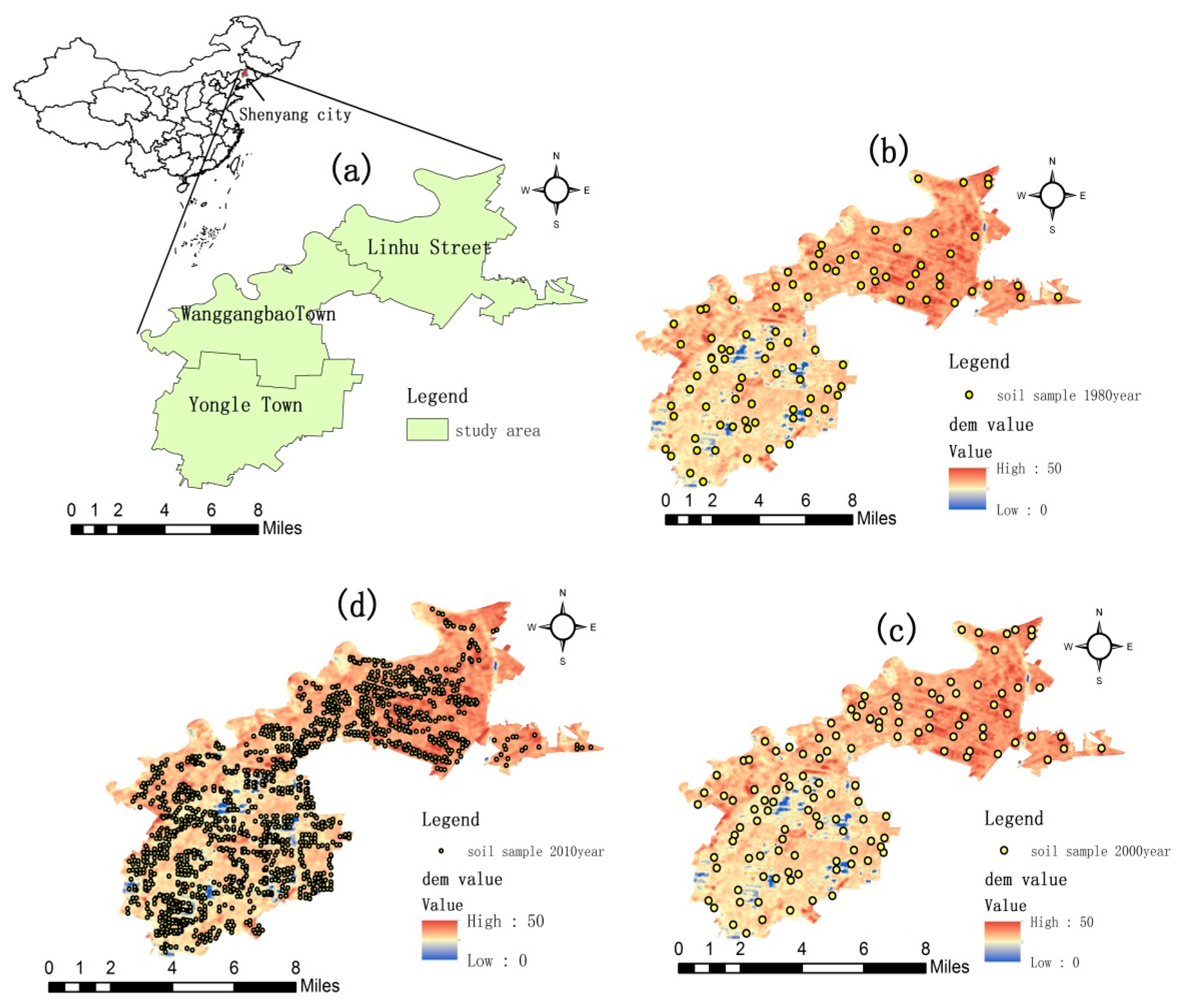
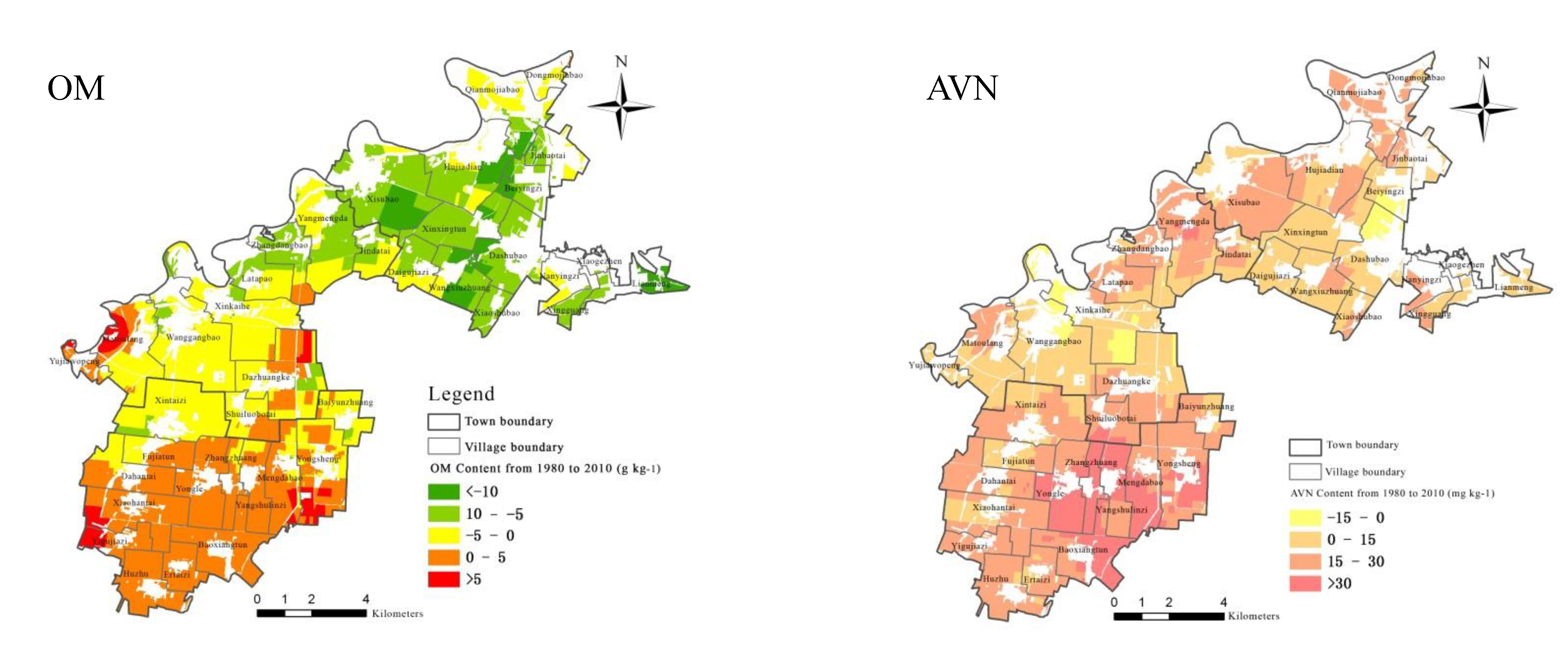

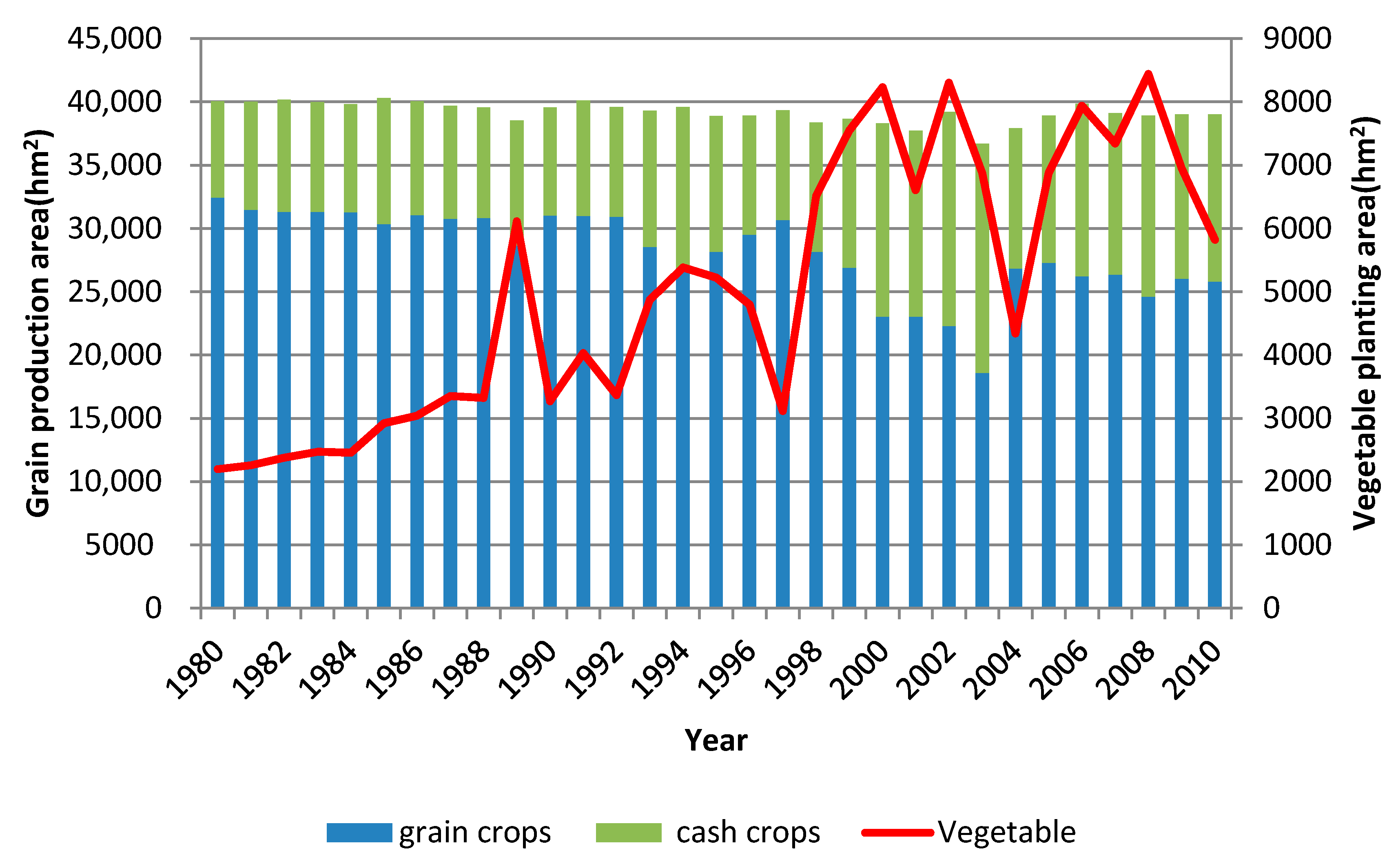
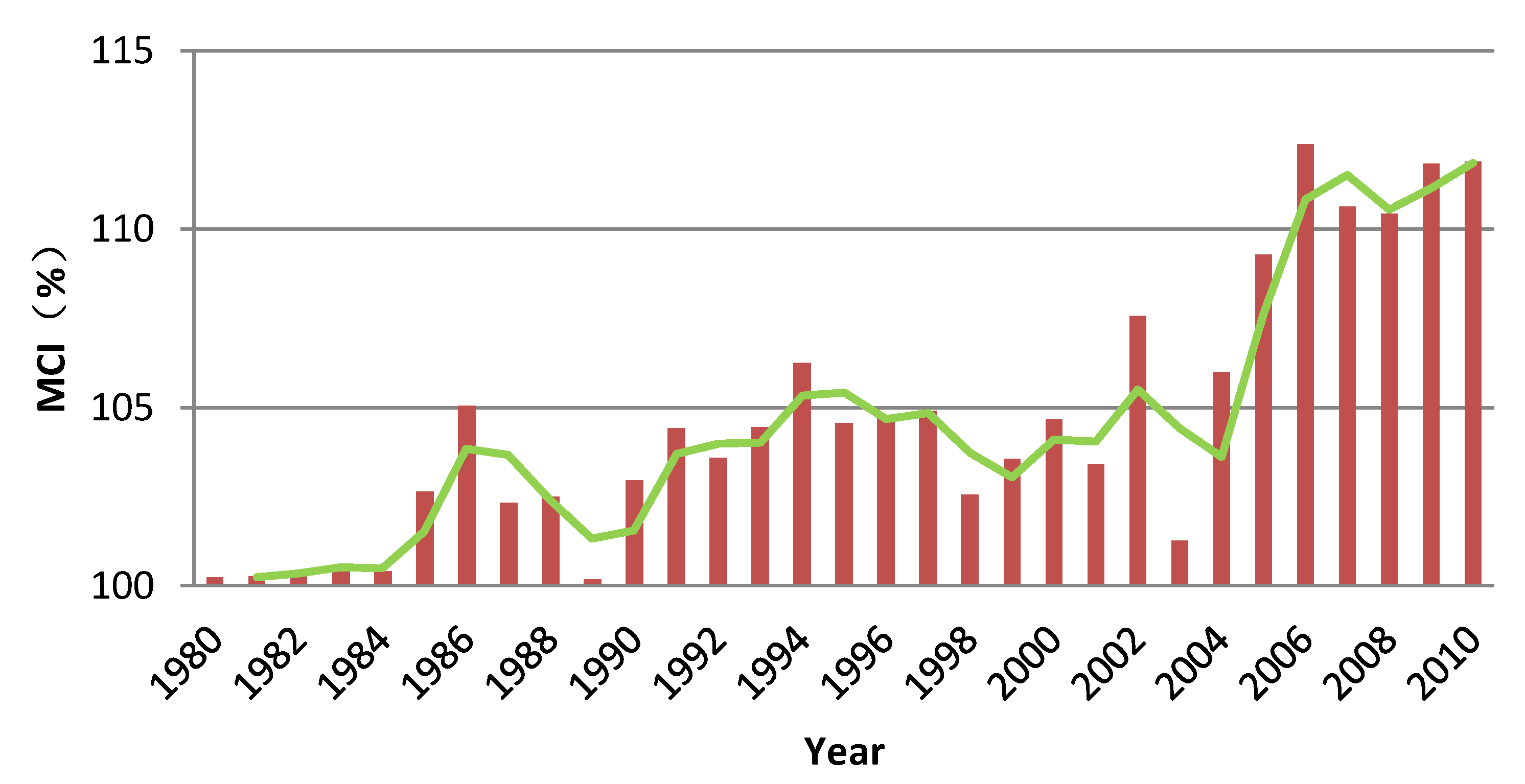
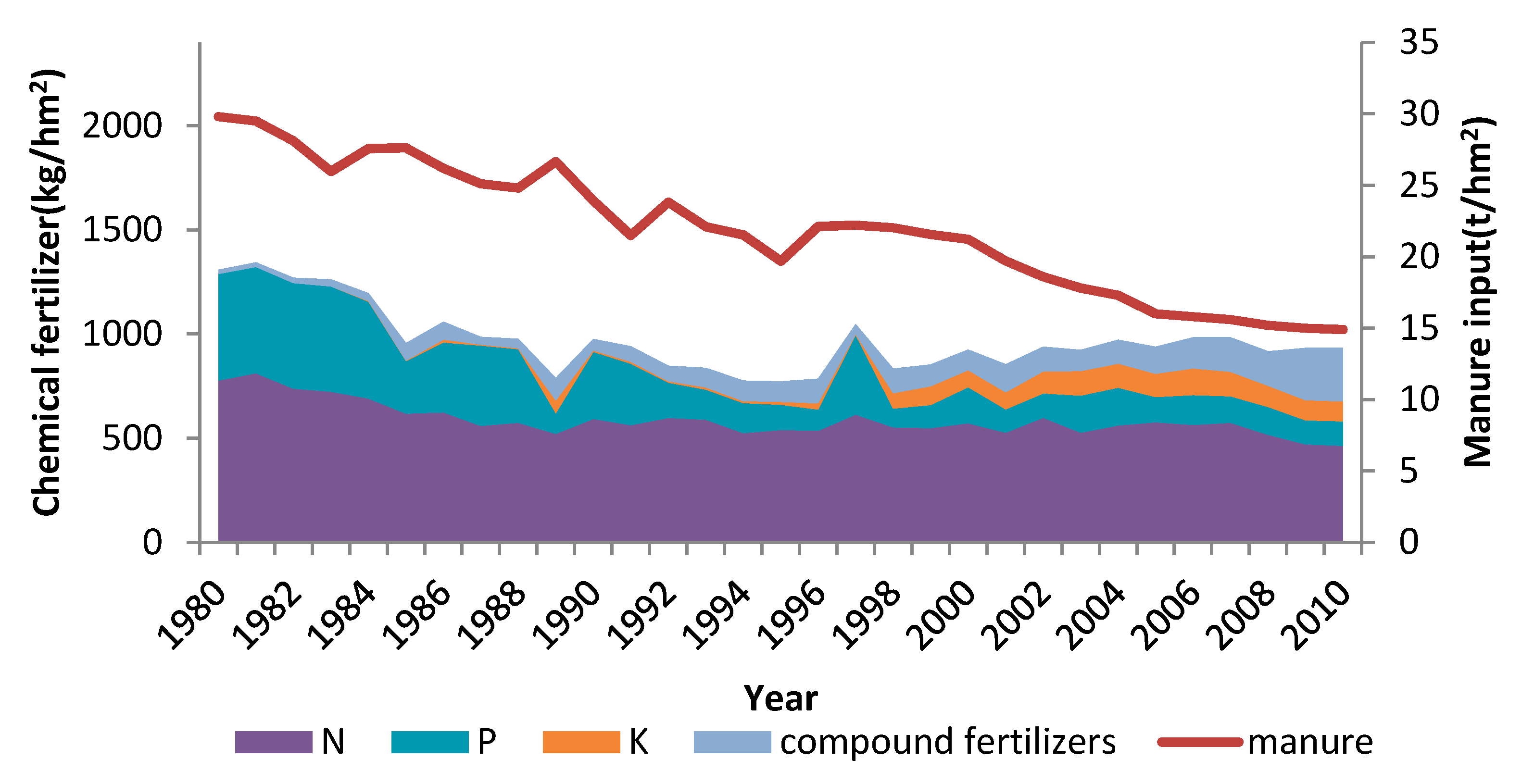
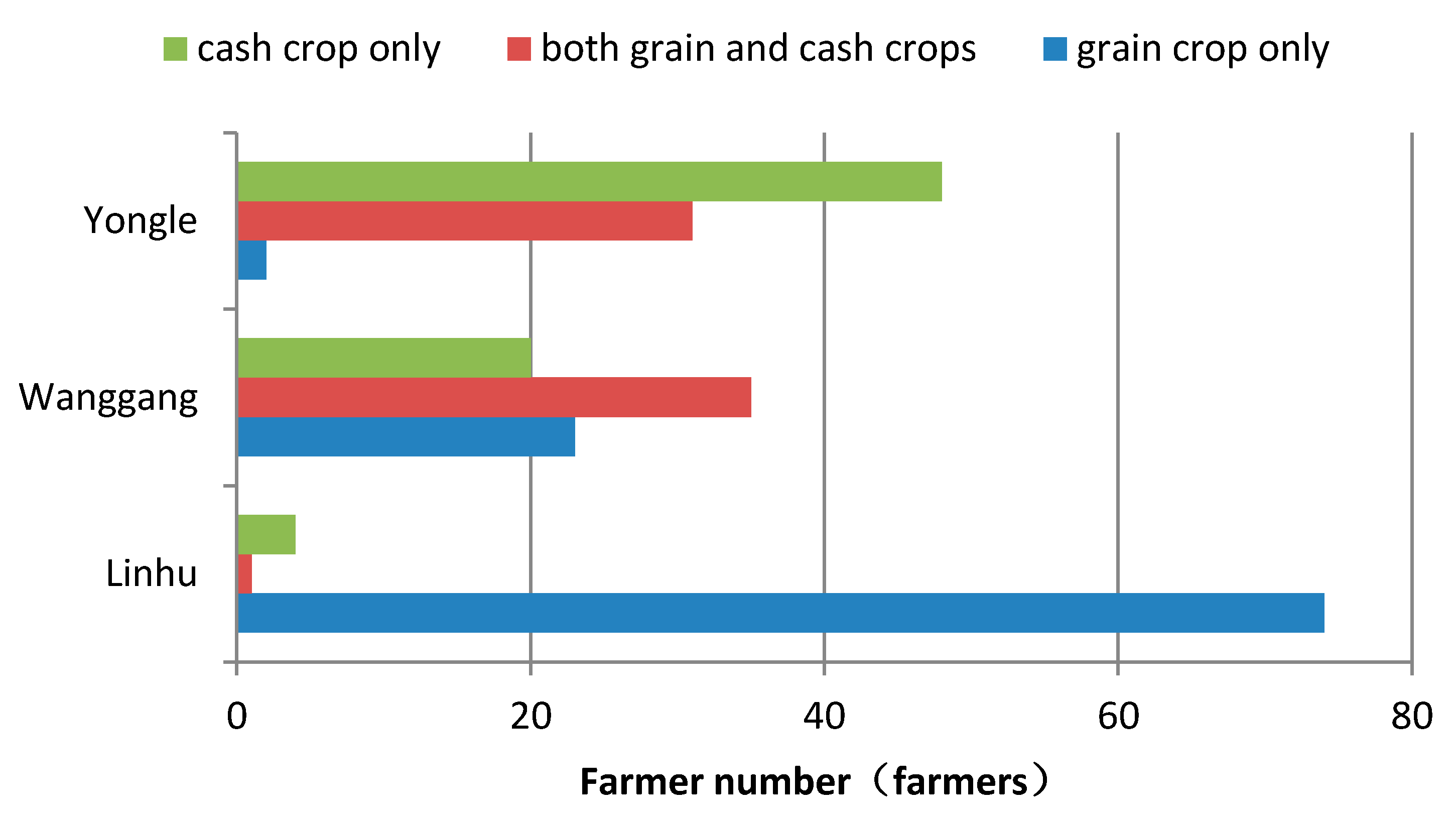
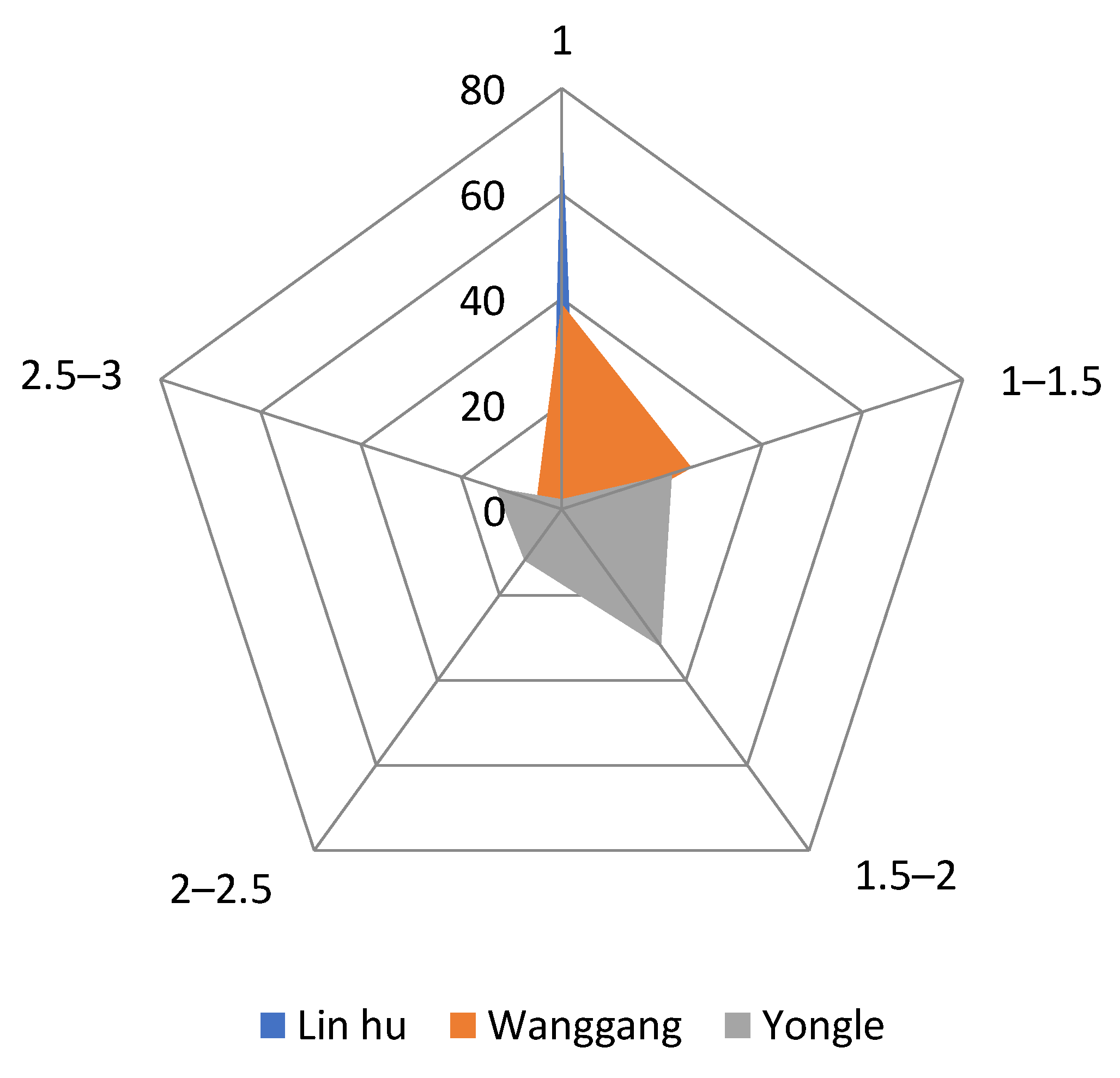

| SB | Year | Mean | Std. dev | Coefficient | Min | Max | Skewness | Kurtosis |
|---|---|---|---|---|---|---|---|---|
| OM (g/kg) | 1980 | 30.88 | 7.05 | 22.83 | 16.84 | 53.87 | 1.032 | 0.934 |
| 2000 | 22.63 | 3.53 | 15.60 | 11.32 | 36.19 | 0.647 | −0.139 | |
| 2010 | 20.07 | 1.62 | 14.63 | 17.87 | 27.71 | 0.511 | 1.187 | |
| AVN (mg/kg) | 1980 | 109.38 | 8.67 | 7.93 | 89.70 | 126.40 | 0.258 | −1.182 |
| 2000 | 108.36 | 7.32 | 6.76 | 95.90 | 135.09 | 0.631 | 0.174 | |
| 2010 | 126.80 | 8.80 | 6.94 | 96.33 | 148.10 | −0.554 | 0.644 | |
| AVP (mg/kg) | 1980 | 11.46 | 6.08 | 53.05 | 4.63 | 46.35 | 1.708 | 4.321 |
| 2000 | 26.32 | 9.32 | 35.41 | 13.49 | 61.92 | 1.015 | 0.798 | |
| 2010 | 54.31 | 12.86 | 26.67 | 17.41 | 84.16 | −0.126 | −0.284 | |
| AVK (mg/kg) | 1980 | 149.58 | 17.96 | 12.01 | 79.69 | 197.65 | 0.083 | −0.103 |
| 2000 | 103.62 | 11.19 | 10.80 | 85.17 | 125.26 | 0.274 | −1.190 | |
| 2010 | 134.29 | 17.21 | 12.82 | 86.67 | 167.95 | −0.012 | −1.004 |
| Item | Grade | Value | 1980 | 2000 | 2010 | |||
|---|---|---|---|---|---|---|---|---|
| Area (hm2) | Percent | Area (hm2) | Percent | Area (hm2) | Percent | |||
| OM (g/kg) | I | >30 | 1577 | 14.1 | 121 | 1.1 | 139 | 1.2 |
| II | 25–30 | 4797 | 42.8 | 5503 | 49.0 | 1324 | 11.8 | |
| III | 20–25 | 2893 | 25.8 | 5313 | 47.3 | 9433 | 84.1 | |
| IV | 15–20 | 1944 | 17.3 | 283 | 2.5 | 250 | 2.2 | |
| V | 10–15 | 9 | 0.1 | —— | —— | 1 | 0.0 | |
| VI | <10 | —— | —— | —— | —— | 74 | 0.7 | |
| AVN (mg/kg) | I | ≥150 | —— | —— | —— | —— | —— | —— |
| II | 135–150 | —— | —— | —— | —— | 1459 | 13.0 | |
| III | 120–135 | 1525 | 13.6 | 641 | 5.7 | 6739 | 60.1 | |
| IV | 105–120 | 4391 | 39.1 | 6394 | 57.0 | 2647 | 23.6 | |
| V | 90–105 | 5306 | 47.3 | 4185 | 37.3 | 376 | 3.4 | |
| VI | <90 | —— | —— | —— | —— | —— | —— | |
| AVP (mg/kg) | I | ≥60 | —— | —— | 42 | 0.4 | 2751 | 24.5 |
| II | 50–60 | —— | —— | 516 | 4.6 | 2937 | 26.2 | |
| III | 40–50 | 16 | 0.1 | 1842 | 16.4 | 3167 | 28.2 | |
| IV | 30–40 | 84 | 0.7 | 2404 | 21.4 | 1803 | 16.1 | |
| V | 20–30 | 895 | 8.0 | 2469 | 22.0 | 537 | 4.8 | |
| VI | <20 | 10226 | 91.1 | 3948 | 35.2 | 26 | 0.2 | |
| AVK (mg/kg) | I | ≥180 | 526 | 4.7 | —— | —— | —— | —— |
| II | 160–180 | 3899 | 34.7 | —— | —— | 527 | 4.7 | |
| III | 140–160 | 3760 | 33.5 | —— | —— | 3657 | 32.6 | |
| IV | 120–140 | 2806 | 25.0 | 856 | 7.6 | 3670 | 32.7 | |
| V | 100–120 | 164 | 1.5 | 5329 | 47.5 | 3072 | 27.4 | |
| VI | <100 | 66 | 0.6 | 5036 | 44.9 | 295 | 2.6 | |
| Region | Independent Variable | Dependent Variable | ||||
|---|---|---|---|---|---|---|
| OM | AVN | AVP | AVK | |||
| Linhu street | WGCC | B | 4.709 * | 42.312 * | ||
| T-value | 1.246 | 1.966 | ||||
| Beta | 0.188 | 0.283 | ||||
| MCI | B | −11.496 * | −44.078 *** | −15.469 * | ||
| T-value | −1.576 | −3.655 | −1.817 | |||
| Beta | −0.240 | −0.532 | −0.282 | |||
| LII | B | 0.026 * | ||||
| T-value | 1.836 | |||||
| Beta | 0.210 | |||||
| Wanggangbao town | WGCC | B | 4.799 * | 7.454 * | 100.170 *** | 61.205 *** |
| T-value | 2.603 | 1.030 | 3.131 | 2.702 | ||
| Beta | 0.424 | 0.175 | 0.413 | 0.399 | ||
| MCI | B | −28.119 * | ||||
| T-value | −1.711 | |||||
| Beta | −0.179 | |||||
| LII | B | 0.027 * | 0.009 * | |||
| T-value | 2.128 | 1.509 | ||||
| Beta | 0.145 | 0.073 | ||||
| Yongle town | WGCC | B | 134.546 * | |||
| T-value | 1.384 | |||||
| Beta | 0.160 | |||||
| MCI | B | −2.725 ** | −51.444 * | |||
| T-value | −2.068 | −1.687 | ||||
| Beta | −0.233 | −0.187 | ||||
| LII | B | 0.007 * | 0.025 * | 0.037 * | ||
| T-value | 1.513 | 1.383 | 1.884 | |||
| Beta | 0.180 | 0.196 | 0.225 | |||
Publisher’s Note: MDPI stays neutral with regard to jurisdictional claims in published maps and institutional affiliations. |
© 2021 by the authors. Licensee MDPI, Basel, Switzerland. This article is an open access article distributed under the terms and conditions of the Creative Commons Attribution (CC BY) license (http://creativecommons.org/licenses/by/4.0/).
Share and Cite
Liu, H.; Lyu, J. Drive Mechanisms of Soil Quality Changes in Peri-Urban Areas. Land 2021, 10, 171. https://doi.org/10.3390/land10020171
Liu H, Lyu J. Drive Mechanisms of Soil Quality Changes in Peri-Urban Areas. Land. 2021; 10(2):171. https://doi.org/10.3390/land10020171
Chicago/Turabian StyleLiu, Hongbin, and Jie Lyu. 2021. "Drive Mechanisms of Soil Quality Changes in Peri-Urban Areas" Land 10, no. 2: 171. https://doi.org/10.3390/land10020171
APA StyleLiu, H., & Lyu, J. (2021). Drive Mechanisms of Soil Quality Changes in Peri-Urban Areas. Land, 10(2), 171. https://doi.org/10.3390/land10020171






